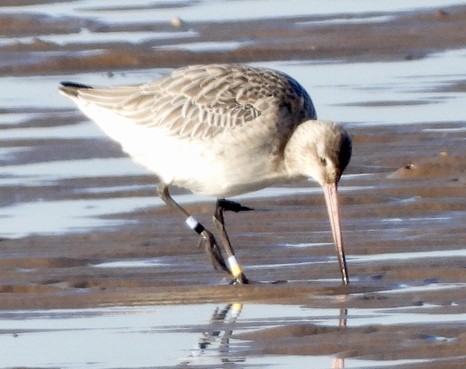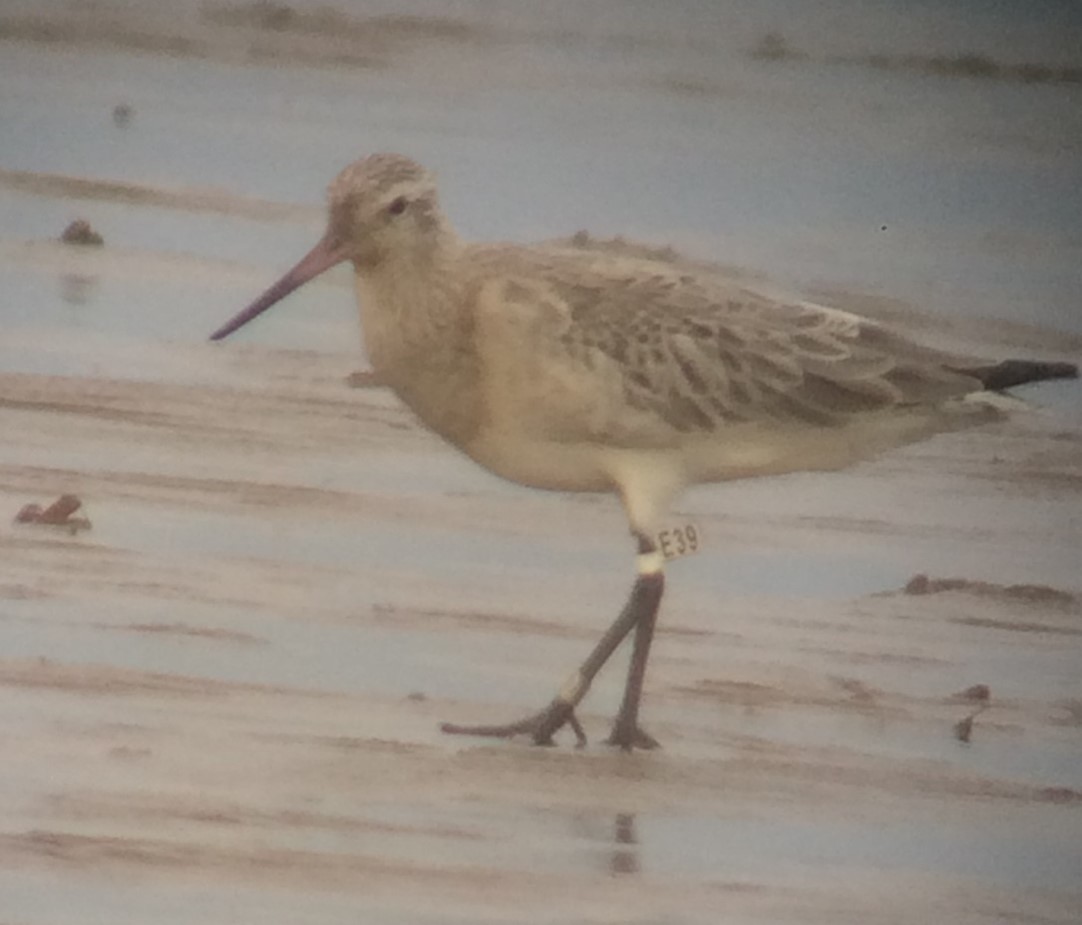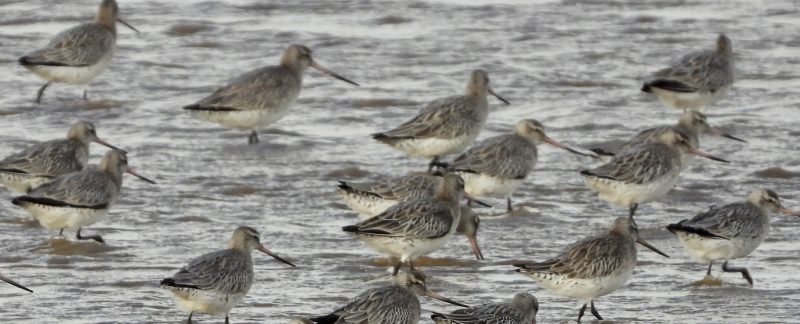Bar-tailed Godwits (Limosa lapponica) are large waders which have a wide distribution across several continents. Five subspecies are currently recognised plus a sixth recently proposed as yamalensis (Appleton 2021). Bar-tailed Godwits are long-distance migrants and one subspecies (baueri) makes an incredible non-stop migration from Alaska to New Zealand over the Pacific Ocean lasting many days.
Two populations of Bar-tailed Godwit use The Wash: lapponica breeds from northern Fennoscandia eastwards to western Russia and the Taymyr peninsula and moults on The Wash in autumn, with most birds staying to spend the winter; taymyrensis breeds further east reaching central Siberia and passes through The Wash on migration to its wintering sites, as far south as West Africa.
Metal-ringing and colour-marking Bar-tailed Godwits
We have been fitting metal rings to Bar-tailed Godwits since 1959, with nearly 10,000 ringed to date. Although historically the number of recoveries has been low (<70), they have played a big part in establishing their breeding areas, migration routes and wintering sites. The recoveries are mainly from the Russian Federation (14), The Netherlands (13) and Germany (15).
As the conservation status of Bar-tailed Godwit has worsened, we began colour-marking Bar-tailed Godwits in 2010 to allow us to estimate their survival rate and pick up any changes. The relatively low number of recoveries of metal rings means we can’t calculate survival, but by colour-marking and then resighting with a telescope or camera we can generate many more recoveries without recapturing the birds.
Since 2010 we have colour-marked over 530 Bar-tailed Godwits. We use a white flag engraved with two letters/numbers on one tibia (which identifies each bird individually) plus a single colour ring (the scheme marker) on the other tibia. The scheme marker identifies when the bird was colour-marked: white (pre 2016), orange (2016 to 2020) and green (2021 onwards). The birds with a green scheme marker have an additional green colour ring below the white flag.
Resighting colour-marked Bar-tailed Godwits does however still require dedicated effort and we run specific resighting fieldwork weekends. The more individuals that can be resighted from autumn to spring the more accurately the survival rate can be calculated. We aim to resight a minimum of 100 individual Bar-tailed Godwits each year and between 2017 and 2020 we have averaged 402 resightings of 170 individuals annually. Around 60% of the Bar-tailed Godwits seen in one year are seen again in the following year (the re-encounter rate) so a particular individual could easily not be seen for a couple of years but could then ‘re-appear’. Our long-term monitoring allows us to work out which individual Bar-tailed Godwits were alive each year.
The practicalities of resighting Bar-tailed Godwits on The Wash
Resighting Bar-tailed Godwits on The Wash is never easy. They seem to spend much of their time just out of reach of even the best quality telescopes, a tantalising silver-grey strip far out on the mudflats.
A degree of planning is necessary to get close enough to them and this involves looking at tide heights and direction and strength of the wind. Bar-tailed Godwits like to roost on the mudflats south of Snettisham and follow the outgoing and incoming tides, feeding on the tide edge. They tend not to leave the roost until the tide has gone out a reasonable way and then fly off in a large flock which can land anywhere along the tide edge between Snettisham and Holme. Outgoing tides are therefore not very productive for resighting, since the tide recedes quickly on The Wash and there is little chance of catching up with the birds. Incoming tides are a far better bet, as well as their main roost or pre-roost sites.
For example, some spring tides which do not quite cover all the mudflats south of Snettisham Pits push Bar-tailed Godwits and other species such as Curlew onto the remaining exposed mud where they roost in long lines facing into wind. Although still quite distant from shore, this is a good opportunity for viewing them provided that there is little wind to cause telescope shake. The birds sleep on one leg giving a 50% chance that this will be the leg bearing the flag.
Incoming tides of moderate height allow a short period of time, particularly on Snettisham beach between the beach car park and Heacham dam, where the birds move close inshore as they use the last possible piece of mud to feed frantically before flying off to the roost. Additionally, on very calm days with a fairly low high tide, it is possible to walk out onto the mudflats almost as far as the low tide edge. The birds readily accept you and move closer as the tide comes in eventually surrounding you as you concentrate on reading their flags. At this point you suddenly realise that it is time to head towards shore yourself!
Selected recoveries and resightings in 2021
In 2021 there have been several recoveries of metal rings as well as resightings of our colour-marked birds:
Metal-ring recoveries:
DD15344, ringed at Leverton Outgate, Lincolnshire on 11 August 2006 and predated by a raptor on 07 May 2021 at Den Helder, The Netherlands.
DD73178, ringed at Friskney, Lincolnshire on 12 August 2010 and recaptured on 16 November 2019 at Salina de Caminhate, Guinea Bissau, West Africa.
Colour-mark resightings:
The following three birds were all resighted in September and October 2021 at de Richel on the Dutch Wadden Sea, where they were probably moulting.
EL09471 (KK-W), ringed at Snettisham on 30 March 2013 – resighted 8 September 2021.
DE42886 (0P-O), ringed at Heacham on 06 January 2018 – on 5 September and 6 October 2021 (also seen on 10 November 2018 at Snettisham.
DE42966 (51-O), ringed at Snettisham on 14 August 2018 – resighted on 7 September and 7 October /2021.
The following bird was resighted at its wintering site in West Africa, and is probably a taymyrensis subspecies bird.
DT35337 (V3-O), ringed at Snettisham on 25 August 2017, recaught by WWRG on 14 August 2018 and resighted on 30 January 2021 at Banc d’Arguin, Mauretania.
The following two birds were resighted during spring migration.
DE85743 (L7-O), ringed at Terrington on 20 July 2016 – resighted on 5 May 2021 at De Cocksdorp,Texel, probably en route to its breeding grounds.
DT35338 (Y5-O), ringed at Snettisham on 25 August 2017 – resighted on 11 May 2021 at Ylitornio, Kauliranta, Finland. This bird would have been on its way to, or possibly arrived at, its breeding grounds.
The following resighting seems to be a non-breeding bird, or a bird returning slightly early from its breeding grounds.
DE42272 (1M-W), ringed at Snettisham on 5 August 2015 and resighted on 17 & 18 July 2021 on RSPB Minsmere scrape, Suffolk.
Whilst the main focus is resighting WWRG colour-marked birds we are always on the look-out for Bar-tailed Godwits that have been colour-marked elsewhere. Three interesting birds resighted on The Wash in 2021 are listed below.
NLA 1637187 N1PYPN, ringed by NIOZ at De Spang, Texel on 18 May 2017 and resighted by them in Texel on 7 July and 14 August 2017. Subsequently resighted on 23 Oct 2021 at Heacham and 22 January 2022 at Snettisham. NIOZ consider that this bird might be a taymyrensis since most Bar-tailed Godwits ringed by them during spring migration are of this subspecies.

NLA 1631138 (N3YGPY), ringed by NIOZ at Terschelling on 16 May 2017 and resighted on 19 April 2021 on Snettisham beach. This sighting was a late date for spring migration of the wintering population of Bar-tailed Godwits on The Wash and the bird was in summer plumage. As this bird was ringed two days before N1PYPN above, perhaps it was also a taymyrensis.
PLG GN37643 (W-E39), ringed by the Polish Ornithological Station, Museum and Institute of Zoology, Polish Academy of Science at Ujście Wisły on 19 September 2020. Resighted on 21 June 2021 at RSPB Frampton Marsh and subsequently on 06 and 12 November 2021 at Heacham. This bird was ringed as a juvenile in Poland and appears to have spent at least summer and autumn 2021 on The Wash.

References
Wernham, C.V., Toms, M.P., Marchant, J.H., Clark, J.A., Siriwardena, G.M. and Baillie, S.R. (eds.) (2002) The Migration Atlas: movements of the birds of Britain and Ireland. T. and A.D. Poyser, London
Blog written by Bernard Siddle

